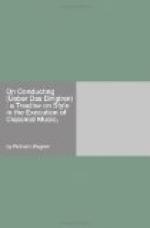[A musical score]
is preceded by the weighty crochets of the fanfare the modification of the tempo must obviously begin at the end of the crochets, that is to say with the more sustained notes of the chord on the dominant which introduces the cantabile. And, as this broader movement in minims continues for some time with an increase in power and modulation, I thought conductors could be trusted to attain the proper increase of speed; the more so, as such passages, when simply left to the natural impulse of the executants always induce a more animated tempo. Being myself an experienced conductor, I counted upon this as a matter of course, and merely indicated the passage at which the tempo returns to the original 4/4 time, which any musician will feel, at the return of the crochets and in the changes of harmony.
At the conclusion of the overture the broader 4/4 time, quoted above in the powerfully sustained march-like fanfare, returns again; the quick figured embellishments are added, and the tempo ends exactly as it began.
This overture was first performed at a concert at Leipzig, when I conducted it as described above. It was so well played by the orchestra that the small audience, consisting for the most part of non-resident friends, demanded an immediate repetition, which the musicians, who agreed with the audience, gladly accorded. The favourable impression thus created was much talked of, and the directors of the Gewandhaus Concerts decided to give the native Leipzig public a chance to hear the new overture.
In this instance Herr Capellmeister Reinecke, who had heard the piece under my direction, conducted it, and the very same orchestra played it—in such wise that the audience hissed! I do not care to investigate how far this result was due to the straightforward honesty of the persons concerned; let it suffice that competent musicians, who were present at the performance, described to me the sort of time the Herr Capellmeister had thought fit to beat to the overture—and therewith I knew enough.
If any conductor wishes to prove to his audience or to his directors, etc., what an ambiguous risk they will run with “Die Meistersinger,” he need take no further trouble than to beat time to the overture after the fashion in which he is wont to beat it to the works of Beethoven, Mozart, and Bach (which fashion suits the works of R. Schumann fairly well); it will then be sufficiently obvious that he is dealing with a very unpleasant kind of music—let anyone imagine so animated, yet so sensitive a thing as the tempo which governs this overture, let this delicately constituted thing suddenly be forced into the Procrustus-bed of such a classical time-beater, what will become of it? The doom is: “Herein shalt thou lie, whatsoever is too long with thee shall be chopped off, and whatsoever is too short shall be stretched!” Whereupon the band strikes up and overpowers the cries of the




